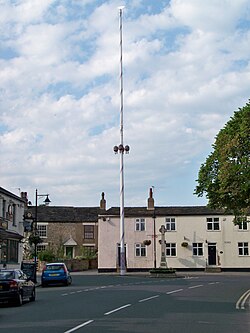Barwick-in-Elmet
| Barwick-in-Elmet | |
|---|---|
 Barwick Maypole |
|
| Barwick-in-Elmet shown within West Yorkshire | |
| OS grid reference | SE399373 |
| Civil parish | |
| Metropolitan borough | |
| Metropolitan county | |
| Region | |
| Country | England |
| Sovereign state | United Kingdom |
| Post town | LEEDS |
| Postcode district | LS15 |
| Dialling code | 0113 |
| Police | West Yorkshire |
| Fire | West Yorkshire |
| Ambulance | Yorkshire |
| EU Parliament | Yorkshire and the Humber |
| UK Parliament | |
Barwick-in-Elmet is a village in West Yorkshire, 7 miles (11 km) east of Leeds city centre. It is one of only three places in the area to be explicitly associated with the ancient Celtic kingdom of Elmet, the others being Scholes-in-Elmet and Sherburn-in-Elmet. It is part of the civil parish of Barwick in Elmet and Scholes. The name Barwick comes form the Old English for "barley wick", and was recorded in the Domesday Book of 1086 as Bereuuith.
Barwick dates back to between 200-600 BC. There are major Iron Age and Norman earthworks in the centre of the village called Wendel Hill and Hall Tower Hill. There is reference to an agricultural settlement in the Domesday Book of 1086. From a taxation survey, it is known that in 1379 there were 197 adults living in about 100 households.
.
For some time the Manor of Barwick and Scholes was in the ownership of the Gascoigne family of Parlington and Lotherton.
In 1720 the first known school in Barwick in Elmet opened. By 1821 the parish had a population of 1,481.
The Cross Gates to Wetherby railway line opened in 1874, with a station in nearby Scholes, enabling residents to commute to Leeds city centre. This service remained running until 1965, when the line closed under the Beeching Axe.
Throughout the 20th century the village grew with many modern houses being built in and around the village by both private developers and the local corporations. During this period many of the older cottages in the village centre were converted into shops and other small business premises.
For much of its history the village supported a mainly agricultural community. From the late 17th century until the early 20th century many residents were employed in the local mining industry in Garforth, Cross Gates and Whitkirk. Today, whilst still having a rural agricultural feel, the village supports many trades as well as housing for people who work in Leeds and York.
...
Wikipedia

